California Housing Market: Prices, Trends, Forecast 2023
The California housing market has shown signs of recovery in May, with home sales reaching the highest level in eight months and the median home price surpassing $800,000 for the second consecutive month. Despite the year-over-year decline in sales and price, the market is demonstrating resilience and stability.
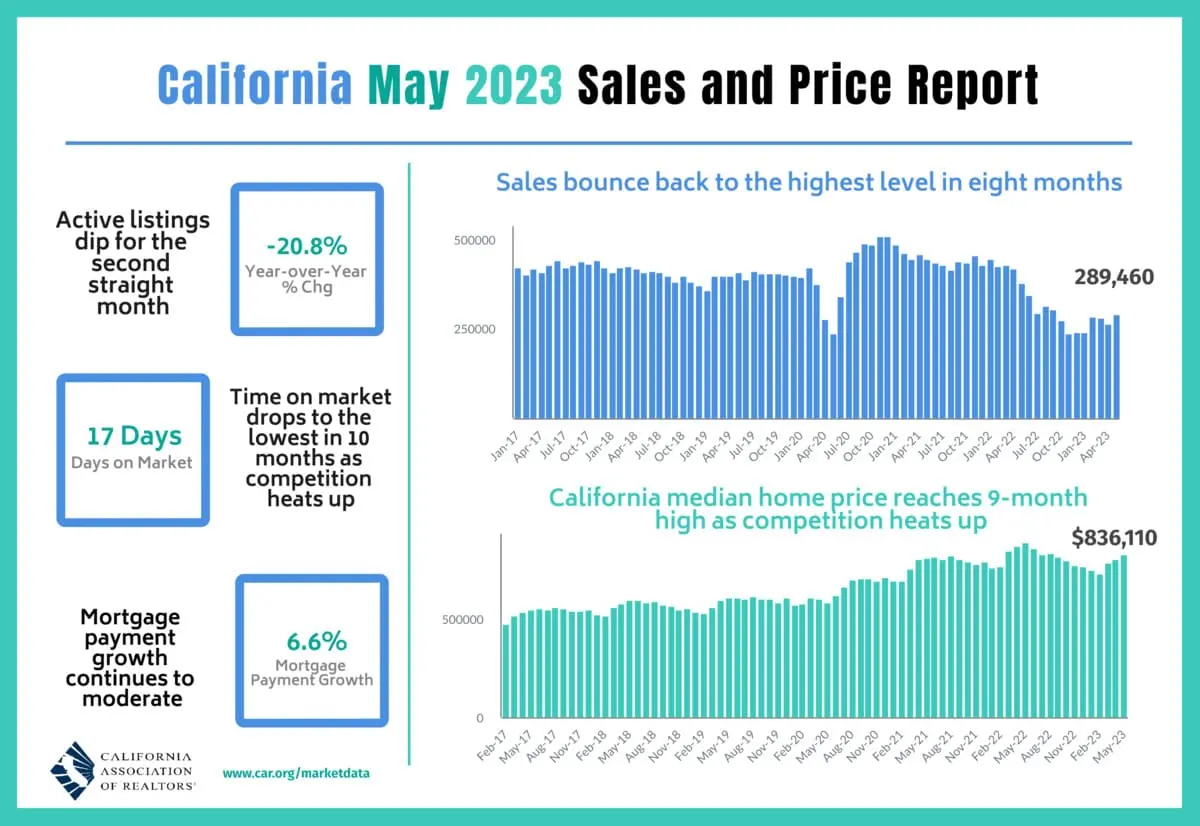
The stats indicate a rebound in California’s housing market. Although sales and prices have declined on a year-over-year basis, the market is showing signs of resilience and stability. Increased competition, fewer price reductions, and a shorter time to pending status are positive indicators for the future. The impact of rising interest rates and the shortage of homes for sale will continue to influence the market dynamics in the coming months. Let’s dive into the details of the May home sales and price report released by the CALIFORNIA ASSOCIATION OF REALTORS® (C.A.R.).
Home Sales Surge to Eight-Month High
In May, existing single-family home sales in California reached a seasonally adjusted annualized rate of 289,460, representing a 9.8% increase compared to April. However, when compared to May 2022, home sales were down by 23.6%. Although the sales figure remained below the 300,000-unit mark for the eighth consecutive month, the rebound in May suggests a positive trend in the market.
Median Home Price Exceeds $800,000 Again
The statewide median home price in California climbed to $836,110 in May, marking a 3.0% increase from April. However, on a year-over-year basis, the median price dropped by 6.4% for the seventh consecutive month. Tight housing supply and an increase in the sale of high-end homes contributed to the upward pressure on prices. Despite the recent improvement, more negative annual price changes are anticipated in the coming months due to expected high interest rates in the third quarter of 2023.
Resilience of California’s Housing Market
C.A.R. President Jennifer Branchini emphasized the resilience of California’s housing market, attributing the bounceback in sales and prices to the value consumers place on homeownership. The market is stabilizing and even showing signs of improvement, with increased competition leading to a higher percentage of homes selling above the asking price and fewer sellers reducing their listing prices. Additionally, homes are going into pending status within two weeks, compared to over 30 days earlier this year.
Regional Sales Performance
While sales declined across all major regions in California, the rate of decline moderated compared to the previous year. The San Francisco Bay Area experienced the largest sales drop at 23.8%, followed by Southern California (22.3%) and the Far North (21.8%). The Central Coast (-17.3%) and the Central Valley (-20.0%) recorded smaller decreases. Nearly all counties tracked by C.A.R. registered a decline in sales from the previous year, with some experiencing significant drops.
Impact of Interest Rates
The recent rise in mortgage rates has had an impact on the housing market, as prospective sellers with low-interest rate mortgages are hesitant to list their homes for sale, contributing to tight inventory. C.A.R.’s Senior Vice President and Chief Economist, Jordan Levine, explained that the shortage of homes for sale continues to put upward pressure on prices. However, with reduced homebuyer demand, the market faces an imbalance between supply and demand.
ALSO READ: Will the US Housing Market Crash?
California Housing Market: Regional Trends
The California housing market continues to exhibit regional variations in May 2023. While some regions, like the Los Angeles Metro Area, witnessed month-to-month price increases, others, such as the San Francisco Bay Area, experienced declines. Similarly, sales figures varied across the regions, with some areas showing significant growth while others faced declines. It is crucial to consider these regional trends when analyzing the overall state of the California housing market.
Los Angeles Metro Area:
The median sold price of existing single-family homes in the Los Angeles Metro Area stood at $765,000 in May 2023. This reflects a 3.4% increase from the previous month but a 5.0% decrease compared to May 2022. Despite the year-over-year decline, the region experienced a substantial increase in sales, with a 20.6% month-to-month growth and a 21.8% year-over-year decline.
Central Coast:
In the Central Coast region, the median sold price for existing single-family homes was $1,000,000 in May 2023. This indicates a 2.0% decrease from April 2023 but a slight 0.5% increase from May 2022. Notably, the region witnessed a significant rise in sales, with a remarkable 36.6% month-to-month increase. However, when compared to the previous year, there was a 17.3% decline in sales.
Central Valley:
With a median sold price of $485,000 in May 2023, the Central Valley region experienced a notable 4.8% month-to-month increase. However, when compared to May 2022, there was a 4.9% decline in prices. Sales in the region followed a similar pattern, with a 22.7% month-to-month growth and a 20.0% year-over-year decline.
Far North:
The Far North region had a median sold price of $380,000 in May 2023, showing a slight 1.3% decrease from the previous month. However, in comparison to May 2022, there was a significant 10.6% drop in prices. On the positive side, the region experienced a substantial 44.8% increase in sales on a month-to-month basis, though there was a 21.8% decline in sales compared to the previous year.
Inland Empire:
In May 2023, the median sold price for existing single-family homes in the Inland Empire region was $574,990. This represented a 1.8% increase from April 2023. However, when compared to May 2022, prices decreased by 3.5%. Sales in the region experienced a modest 13.9% month-to-month growth but a significant 22.9% year-over-year decline.
San Francisco Bay Area:
The San Francisco Bay Area had a median sold price of $1,300,000 in May 2023. This indicated a 4.0% increase from the previous month but an 11.3% decrease from May 2022. Sales in the region experienced a notable 30.0% month-to-month growth, but there was a substantial 23.8% decline compared to the previous year.
Southern California:
In May 2023, the median sold price for existing single-family homes in Southern California was $800,000. This represented a modest 1.9% increase from the previous month. However, compared to May 2022, there was a 5.3% decrease in prices. The region also experienced a 19.4% month-to-month growth in sales, but there was a significant 22.3% decline in sales compared to the previous year.
California Housing Market Forecast 2023: Recently Revised
Based on the latest data and market conditions, the California Association of Realtors (C.A.R.) has revised its Housing Market Forecast for 2023. The forecast provides insights into the projected trends and expectations for the housing market in the state. Overall, it indicates a challenging market environment in California, with a decline in home sales and a projected decrease in median home prices compared to the previous year.
The revised Housing Market Forecast, released in April 2023, differs from the California Housing Forecast released by the C.A.R. on October 12, 2022. Here are the key differences between the two forecasts:
Existing Single-Family Home Sales:
- October 2022 Forecast: The forecast projected existing single-family home sales to total 333,450 units in 2023, representing a decline of 7.2% from the projected pace of 359,220 units in 2022.
- April 2023 Revised Forecast: The revised forecast estimates a steeper decline in existing single-family home sales, with 279,900 units projected to be sold in 2023. This reflects an 18.2% decrease compared to the 342,000 units sold in 2022.
Median Home Price:
- October 2022 Forecast: The forecast predicted a decline in California’s median home price by 8.8% to $758,600 in 2023, following a projected 5.7% increase to $831,460 in 2022.
- April 2023 Revised Forecast: The revised forecast also expects a decline in the median home price, but the projected figure is slightly higher at $776,600, reflecting a 5.6% decrease from the median price of $822,300 recorded in 2022.
Overall, the revised forecast released in April 2023 indicates a more pessimistic outlook for the California housing market compared to the October 2022 forecast. It predicts a steeper decline in home sales and a slightly higher median home price decrease. These adjustments likely reflect the changing market conditions and factors influencing the California housing market over time.
The revised forecast takes into account various factors influencing the housing market, such as mortgage rates, inventory levels, buyer demand, and economic conditions. The decline in home sales is primarily attributed to higher mortgage rates and the limited availability of homes on the market. These factors have contributed to a decrease in buyer activity and overall sales volume.
Despite the decline in sales, the median home price in California is expected to remain relatively high. The increase in market competition, with homes spending less time on the market and a higher percentage of homes selling above asking price, has influenced the rise in median home prices.
It is important to note that the forecasted figures are based on current market conditions and historical trends. However, unforeseen events or changes in economic factors can influence the actual performance of the housing market throughout the year.
Here’s the snapshot of the California Housing Forecast for 2023 which was released by the C.A.R. on October 12, 2022.
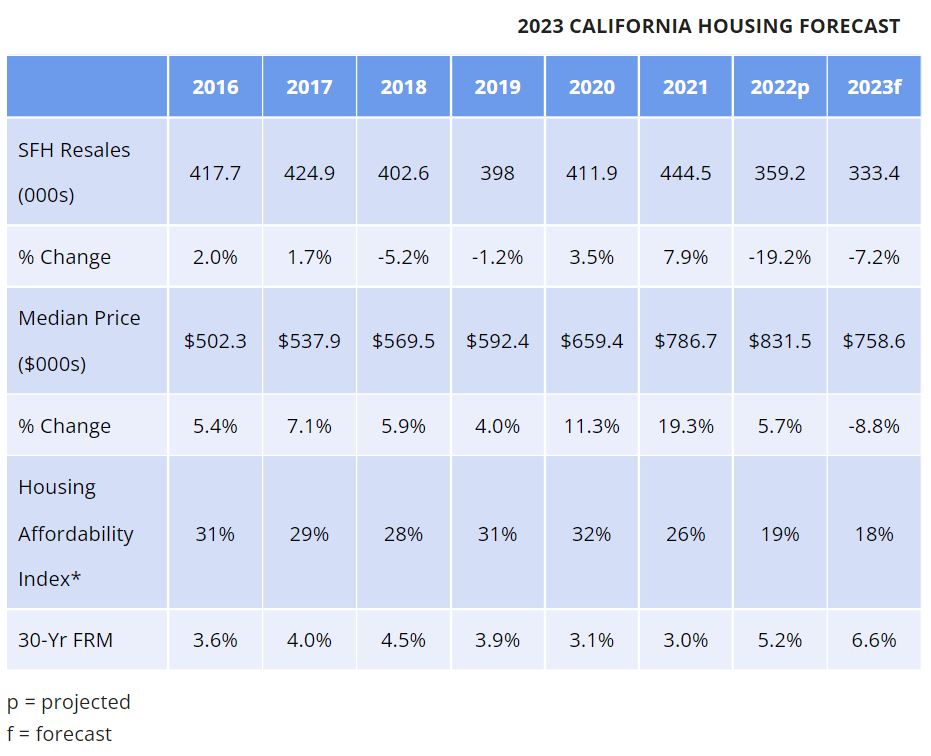
Housing Market Forecast for California Metro Areas
Let us look at the price trends recorded by Zillow over the past year. Based on Zillow’s data and CAR’s data, the California housing market is expected to experience a slowdown in 2023 and 2024. According to Zillow, the average home value in California is $737,900, down 4.3% over the past year, and homes go pending in around 13 days. Zillow’s data also shows that 40.3% of sales go over the list price, while 44.9% go under the list price, indicating that the market is becoming more favorable for buyers.
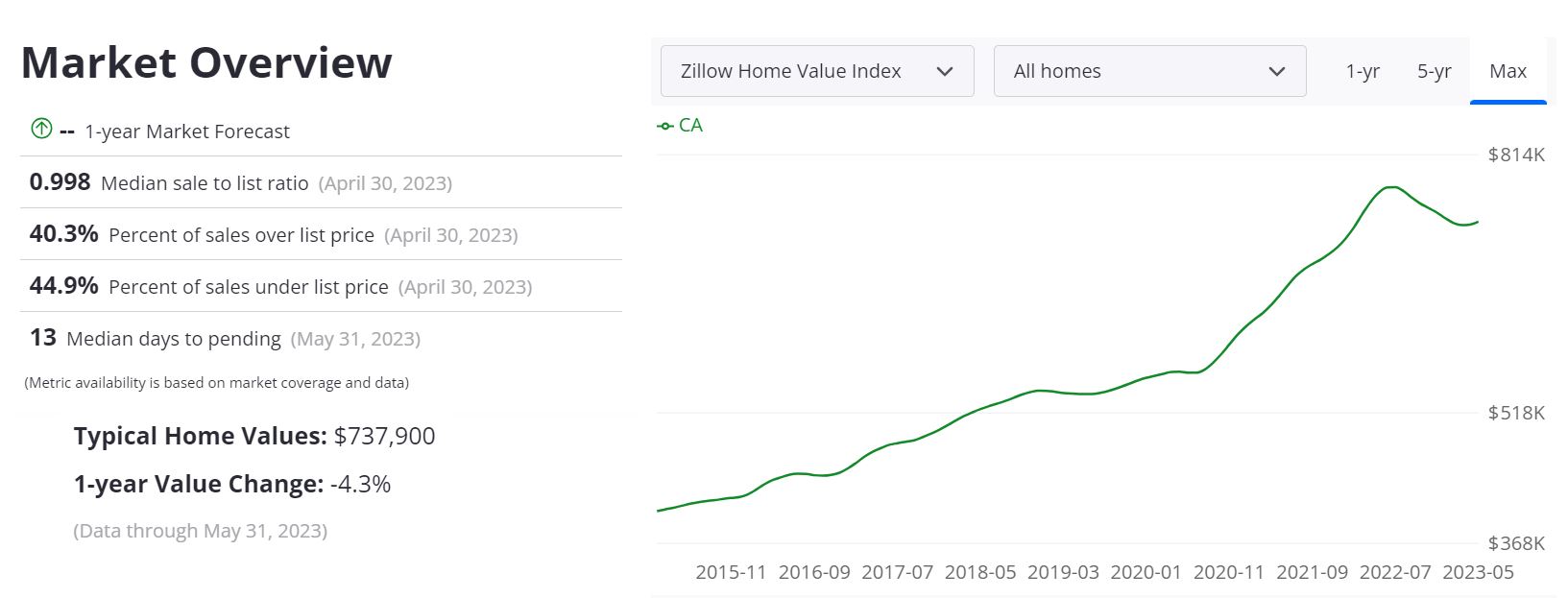
The California housing market is always a topic of interest due to its dynamic nature and significant impact on the state’s economy. As we look ahead to the future, it’s natural to wonder how the housing market will perform in the coming years. Based on the latest data and forecasts, here are the top 10 areas in California where housing prices are projected to rise by 2024:
Santa Maria, CA: Santa Maria is expected to experience a steady increase in housing prices, with a forecasted rise of 6.9% by 2024. This growth reflects a positive outlook for the local housing market.
Madera, CA: The housing market in Madera is also anticipated to see a rise in prices, with a projected increase of 6.1% by 2024. This suggests that Madera is poised for modest growth in the coming years.
Bakersfield, CA: Bakersfield, a prominent city in the Central Valley, is forecasted to have a 5.8% increase in housing prices by 2024. This indicates a positive trend in the local real estate market.
Hanford, CA: Hanford is another area in the Central Valley that is expected to experience a 5.7% rise in housing prices by 2024. This suggests a favorable market for homebuyers and sellers in the region.
Visalia, CA: Visalia, located in the San Joaquin Valley, is projected to see a 5.3% increase in housing prices by 2024. This indicates a stable housing market with modest growth potential.
Riverside, CA: Riverside, a significant metro area in Southern California, is forecasted to have a 5.0% rise in housing prices by 2024. This suggests continued demand and market stability in the region.
Fresno, CA: The housing market in Fresno is expected to see a 5.0% increase in prices by 2024. This indicates a positive market outlook and potential for growth in the coming years.
Merced, CA: Merced, located in the Central Valley, is projected to have a 4.9% rise in housing prices by 2024. This suggests a stable market with moderate growth opportunities.
Salinas, CA: Salinas, situated on the Central Coast, is forecasted to experience a 4.8% increase in housing prices by 2024. This indicates a positive market outlook for the city.
Los Angeles, CA: Los Angeles, the largest metropolitan area in California, is projected to see a 4.3% increase in housing prices by 2024. Despite its already high prices, this forecast suggests continued demand and potential appreciation in the housing market.
It’s important to note that these forecasts are based on current trends and data, and market conditions can change. Various factors, including economic growth, population trends, and housing supply, can influence the housing market’s performance in these areas.
California Housing Market – Weekly Report – June 17, 2023
The California housing market is constantly evolving, influenced by various factors such as interest rates, inflation, job growth, and buyer demand. In this week’s report, we’ll examine the latest trends and insights shaping the housing market in the Golden State.
Federal Reserve Pauses Rate Hikes: In their latest Federal Open Market Committee (FOMC) meeting, the Federal Reserve decided to hold the Fed funds rate steady. However, Fed Chairman Powell indicated that they are prepared to raise rates further this year to address persistent inflation. The bond market had previously anticipated one more rate increase by the end of 2023, but the pause in rate hikes suggests that interest rates will remain elevated longer than expected.
California Housing Market Bounces Back: After experiencing consecutive dips in sales in March and April, the California housing market showed signs of recovery in May. Sales of existing homes surged nearly 10% on a monthly basis, reaching the highest level in eight months. The availability of lower mortgage rates in April likely prompted homebuyers to initiate transactions that closed in May. Although home sales still declined by double digits compared to the same period last year, the yearly drop was relatively mild, indicating a potential stabilization of the market.
Inflation and Mortgage Rates: Inflationary pressures have been a concern, impacting mortgage rates. The Freddie Mac 30-year fixed-rate mortgage remained steady at an average of 6.7% for the week ending June 11th. However, there are expectations of rates potentially rising above 7%, driven by a rise in 10-year Treasuries. Additionally, the Fed’s indication of potential rate hikes may delay the return to sub-6% rates that some had anticipated.
Mortgage Applications Stabilize: New mortgage purchase applications saw a notable increase of 17% last week, breaking a streak of six consecutive weekly declines. While year-over-year declines in applications have slowed, there is still a relative depression in new purchase applications compared to pre-pandemic levels. This indicates that rates have impacted purchasing power and highlights the ongoing challenge of tight inventory in the California housing market.
California Job Growth Slows: Job growth in California has decelerated, but the state continues to add jobs. In May, employers added 40,000 new jobs, following a revised 70,000 increase in April. The year-over-year gains stood at 2.4%, well below the average seen during the reopening phase. The unemployment rate remained steady at 4.5%, as the labor force expanded with re-entering workers. While signs of a labor shortage persist, the gradual thawing of the job market is evident.
Mixed Macro Indicators: Several macro indicators suggest an overall positive outlook for the economy. Small businesses showed increased optimism in May, although many anticipate raising prices in the near future. While manufacturing activity rose slightly, the industrial production index experienced declines in mining and utilities sectors. Retail sales saw a growth of 1.6% year-over-year, but when adjusted for inflation, real retail spending has been falling for the past four months. These indicators indicate a more lackluster growth in the second half of 2023.
Depressed Labor Force Participation Rate: The labor force participation rate remains low for workers aged 55 and above, despite recovery for younger workers. Early retirements during the pandemic, driven by rising home prices, have created a shortfall in experienced workers, contributing to the labor shortage. This situation has also led to faster wage growth and has played a role in keeping inflation from declining at a faster rate.
Is It a Good Time to Buy a Home in California?
The California housing market has experienced fluctuations in recent months, with various factors influencing buyer sentiment and market conditions. To assess whether it’s a good time to buy a home in California, let’s examine some key data and indicators.
Sales Activity: The daily average for closed sales, pending sales, and new listings provide insights into market activity. In the week ending June 17, 2023, there were 454 closed sales per day, indicating a consistent level of transactions. This suggests that buyers are actively engaging in the market.
REALTOR® Sentiment: The opinions of real estate professionals can provide valuable insights. According to the California Association of REALTORS® (C.A.R.), the percentage of REALTORS® who believe sales will increase in the foreseeable future stands at 26.2%. While this is a decrease of 3.5% from the previous week, it still indicates a relatively positive outlook for sales activity.
Price Expectations: Another factor to consider is price projections. C.A.R. reports that 25.7% of REALTORS® surveyed believe that prices will increase. Although this reflects a marginal increase of 0.1% from the previous week, it suggests that there is a degree of optimism regarding potential price appreciation.
Listing Supply: The availability of listings plays a crucial role in the buying process. C.A.R.’s survey indicates that 26.6% of responders expect listings to increase. However, this figure shows a decline of 5.2% from the previous week, suggesting that the inventory may remain relatively tight.
Considering these factors, the current California housing market presents a mixed picture. While sales activity remains steady and there is a level of optimism among REALTORS® regarding future sales and price increases, the availability of listings may continue to be a challenge.
When determining whether it’s a good time to buy a home in California, prospective buyers should consider their individual circumstances, such as financial readiness, personal preferences, and long-term goals. It may be beneficial to work with a trusted real estate agent who can provide personalized advice based on the specific market conditions in the desired area.
Ultimately, the decision to buy a home in California should be based on careful consideration of various factors, including market conditions, affordability, and personal circumstances.
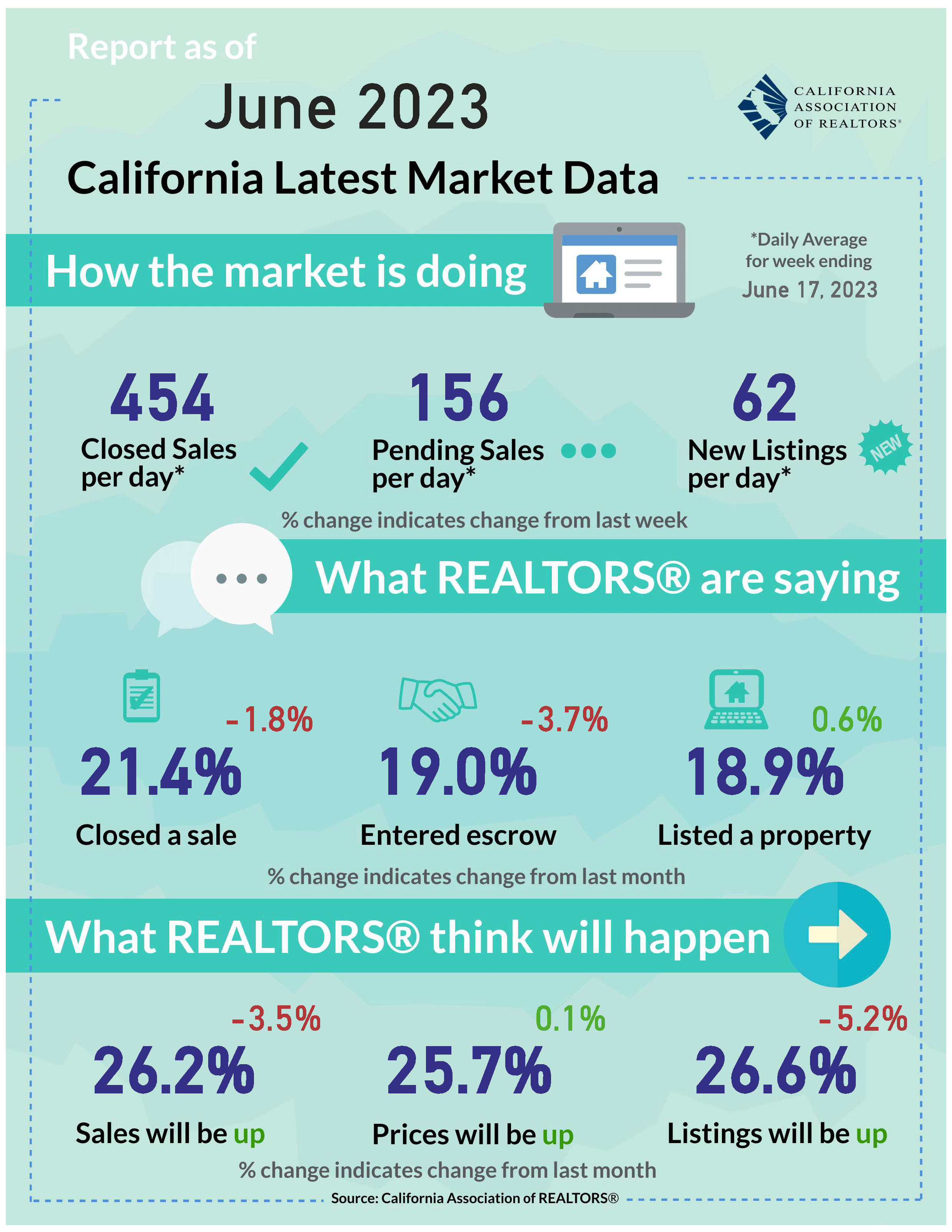
Housing Affordability Trends in California – 1st Quarter 2023
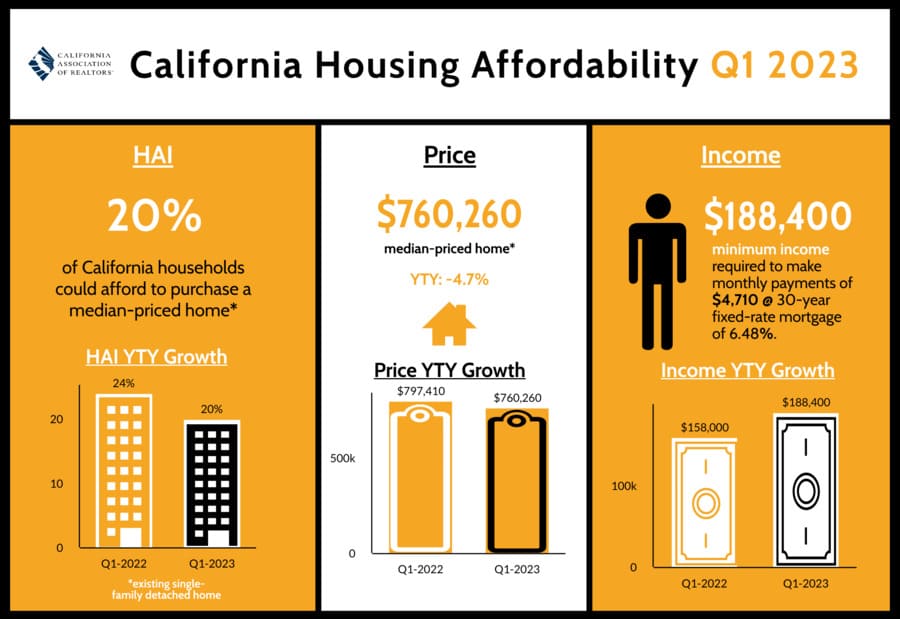
The California housing market experienced a significant shift in the first quarter of 2023, with rising affordability levels due to declining home prices and lower borrowing costs. According to a report released by the CALIFORNIA ASSOCIATION OF REALTORS® (C.A.R.), housing affordability in the state reached its highest level in a year during this period.
- Twenty percent of California households could afford to purchase the $760,260 median-priced home in the first quarter of 2023, up from 17 percent in the fourth quarter of 2022 and down from 24 percent in first-quarter 2022.
- A minimum annual income of $188,400 was needed to make monthly payments of $4,710, including principal, interest and taxes on a 30-year fixed-rate mortgage at a 6.48 percent interest rate.
- Twenty-six percent of home buyers were able to purchase the $619,900 median-priced condo or townhome. A minimum annual income of $153,600 was required to make a monthly payment of $3,840.
Rising Affordability in California
During the first quarter of 2023, housing affordability in California showed promising improvement compared to previous quarters. The percentage of households able to afford the median-priced home rose to 20 percent, up from 17 percent in the fourth quarter of 2022. However, it declined from 24 percent in the first quarter of 2022.
To purchase a median-priced home valued at $760,260, a minimum annual income of $188,400 was required. This calculation considered a 30-year fixed-rate mortgage at an interest rate of 6.48 percent, including principal, interest, and taxes. While these figures indicate progress, they are still far below the peak of 56 percent affordability observed in the first quarter of 2012.
Regional Affordability Analysis
Affordability indices were calculated for various regions and counties within California, providing a comprehensive perspective on the housing market across the state.
- Los Angeles Metro Area: The affordability index for this region improved to 19 percent in the first quarter of 2023, compared to 18 percent in the previous quarter.
- Inland Empire: Housing affordability remained stable in the Inland Empire, with an affordability index of 24 percent.
- San Francisco Bay Area: Affordability levels remained consistent with the previous year, with an index of 21 percent. However, the high median home price in this area, projected at $1,120,000 for 2023, poses a significant challenge for homebuyers.
- United States: In comparison to the national average, which saw an affordability index of 40 percent, California’s housing market proved to be less affordable, with an index of 20 percent.
County Affordability Analysis
The report also highlighted affordability indices for specific counties within California, shedding light on local market dynamics.
- Most Affordable Counties: Lassen County ranked as the most affordable county in the state, with an affordability index of 53 percent. It was followed by Plumas County at 42 percent and Siskiyou County at 41 percent.
- Least Affordable Counties: Mono County, along with San Luis Obispo, Monterey, and Orange Counties, shared the distinction of being the least affordable, each with an affordability index of 12 percent. These counties required a minimum annual income of at least $208,000 to purchase a median-priced home.
- San Mateo and Santa Clara Counties: These two counties in the San Francisco Bay Area continued to be among the least affordable areas in the state. San Mateo County had an affordability index of 15 percent, while Santa Clara County had an index of 16 percent. The high cost of living and strong demand in the tech-driven region contributed to the challenges faced by prospective homebuyers.
Sources:
- https://www.car.org/
- https://www.car.org/aboutus/mediacenter/newsreleases
- https://www.car.org/marketdata/data/countysalesactivity
- https://www.car.org/marketdata/marketforecast
- https://www.car.org/marketdata/marketminute
- https://www.car.org/marketdata/interactive/housingmarketoverview
- https://www.zillow.com/ca/home-values

 Facebook
Facebook
 X
X
 Pinterest
Pinterest
 Copy Link
Copy Link

